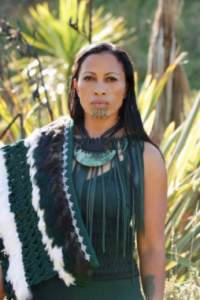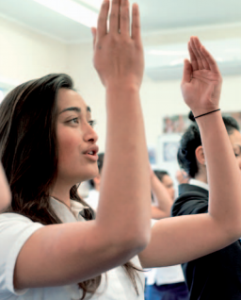Whare Isaac Sharland was awarded a Dr Vince Ham eFellowship in 2017. Her research investigated the benefits of kapa haka on teaching and learning.
In this blog Whare explains how kapa haka can help students develop a positive cultural identity resulting in increased confidence, engagement, and achievement.
Ko Tāwhiuau rāua ko Hikurangi ōku maunga.
Kō Waiawa rāua ko Rangitaiki ōku awa.
Ko Ngati Whare rāua ko Ngāti Ruapani ōku hapū.
He uri ahau ō Ngāti Kahungunu ki Te Wairoa, rāua ko Ngāti Manawa ki Murupara.
Ngā tukemata ō Kahungungu, ko Tangiharuru te tangata, ko Apa-Hāpai-Take-Take te whare.
Ko Whare Isaac-Sharland tōku ingoa.
Tēnā koutou katoa.
Project origins
In 2016 I was astonished to hear a parent suggest that kapa haka provides no real potential for our tamariki, and disappointed that this viewpoint was supported by other teaching staff within our Te Aho Matua kura.
When I was growing up kapa haka was my salvation. I’m not sure if I would have survived mainstream secondary school if I didn’t have kapa haka to enjoy three times each week. Kapa haka allowed me to reconnect with my tūpuna and see myself in the learning – the practices were sacred to me.
Through kapa haka I gained confidence, I grew hungry for further knowledge about my culture, I found the place where I belonged after feeling alienated from my learning environment for so long. These experiences increased my confidence, contributed towards a positive identity of myself, reconnected me to kaupapa tuku iho such as whakapapa, whānau, te reo Māori me ōna tikanga. In short, kapa haka helped me further value my taha Māori.
However, a void seems to exist where some Māori parents, teachers, and whānau cannot align the benefits of kapa haka with positive student learning. A clear path of understanding needs to be created, in order that the positive transformational learnings of kapa haka can be realised by ākonga, whānau, and kaiako.
There is very little research around the impact of kapa haka on learning, language, culture, and identity. From personal experience and practice, I have an intuitive hunch that kapa haka provides invaluable insights because it is based on the validation of the diverse and rich fabric inherent within Māori systems of knowledge. My experiences in the world of kapa haka provided me with a line of inquiry, and ensured the lens throughout my 2017 research project remained kaupapa Māori focused.
Ngā mahi o te rēhia – Understanding kapa haka
Kapa haka is much more than a 20 minute competitive bracket. It is a catalyst for change that has a fundamental link to, and is a powerful medium of Māori identity, culture, and pride.
Kapa haka plays a large role in the revitalisation of the Māori language and Māori cultural values. It enhances positive well-being by encouraging a sense of belonging, providing a "safe haven" in which to practice te reo me ōna tikanga, whilst reinforcing social collaboration and cohesion. These understandings are capitalised upon within this research.
My research methodologies
Kaupapa Māori methodology (Smith, 1997) was my underlying research approach, and is deeply embedded throughout the project’s infrastructure. Although kaupapa Māori theory continues to evolve, it is often considered to be a theory that:
- literally envelopes “a Māori way"
- connects to Māori philosophy and principles
- validates and legitimises Māori systems of knowledge
- values the importance of Māori language and culture
- assumes Tino rangatiratanga over our own cultural well-being.
This project acknowledges and values Māori ways of knowing such as the absolute entrenchment of te reo Māori me ōna tikanga, and aims to create positive results that progress Māori aspirations (Pihama et al., 2004). An insider researcher (Walter, 2010) approach was also applied.
The notion of student voice was also part of my methodology, encompassing the traditional Māori values of “talking story” as a wayfinding mechanism. There were no limitations to how students could express their ideas and beliefs, which gave students the opportunity to create a meaningful project for themselves as well. This was achieved by encouraging students to help me understand what Kapa Haka means to them, alongside hui to assist students in identifying and explaining the myriad of feelings they were experiencing.
Two guiding questions were identified and were the basis for my project findings:
1. Does kapa haka have the potential to positively influence student learning?
2. Could such an understanding positively transform teacher practice?
Return to top
Project findings
My inquiry found that kapa haka does have the potential to positively influence student learning. This occurs in the way kapa haka makes students feel; more specifically, the positive feelings that students experience when doing or watching kapa haka. This understanding could lead to improved teacher practices.
Kapa haka can enhance student belonging and awareness
Kapa haka reinforces a sense of belonging, strengthening whakawhanaunatanga, which plays a huge role toward positive feelings experienced. Students identified that kapa haka is a gift handed down from ātua, acknowledging traditional Māori understandings, providing an avenue for students to express topical issues, whilst allowing them to celebrate their unique Māoriness. Akonga considered kapa haka a powerful form of learning.
Kapa haka can improve teacher practices
My findings also indicate that understanding the positive feelings students experience because of kapa haka, can significantly contribute toward positive teacher practices. Student voices emphasised kapa haka as a positive influence with their overall wellbeing. More importantly, students felt they belonged, they felt safe and they felt nurtured, which occurred in the authentic relationships developed within kapa haka interactions, reflected through the practices of whakawhanaunatanga, tika, pono, and manaakitanga to name a few.
Students are at the heart of this project. Their voices and experiences were integral within this study. My findings could influence decisions that are made about teaching and learning programmes for Māori and non-Māori students alike. There is much potential to transform classroom practices by utilising the legitimacy and validity of kapa haka as a solid culturally preferred practice that enhances student learning and positively influences student outcomes.
Furthermore, the impact on teacher practices could potentially contribute a structured student learning programme that elevates kapa haka as a mana enhancing approach to teaching and learning, reinforcing positive student outcomes.
Kapa haka is an act of disruption and reclamation
As an educated adult, I advocate the notions of disruption and reclamation. I choose to disrupt non-Māori cultural and educational norms by advocating for kapa haka as a powerful teaching and learning approach. I do this by normalising Māori language and kapa haka within Māori and non-Māori worlds. For me, this is an act of reclamation of tāonga tuku iho Māori, which validates our traditions, knowledge, and ways of being, ensuring they are not lost to us.
The misunderstanding demonstrated by various individuals, whānau, and educators alike that kapa haka has no worth, has no value, and therefore can make no real contribution to learning programmes leaves me apprehensive for the future of our tamariki. This belief, by implication, deems Māori culture as unworthy and without value within our schooling system.
Many of our students continue to be marginalised by our mainstream learning environments. It is these akonga that have so much more to lose if actions are not taken now. I suggest the pedagogy and content of kapa haka can act as a positive intervention in these settings.
Future focus – Ideas for teacher practice
This project is merely a beginning point. Despite being small-scale, from a culturally responsive perspective it propels school, kura, kaiako, and whānau to look seriously at the academic and social merits of kapa haka and its significance in nourishing whakapapa, language, culture, and identity.
This is not my story alone. This is the story of my students as well. They revealed all the same reasons that I needed kapa haka as a young Māori teenager finding my way 30 years ago. The lens on kapa haka needs adjusting to better reflect the true nature of kapa haka and their voices clearly support this.
There is potential for a more comprehensive examination of how kapa haka could positively assist with Māori student learning in both Māori and English mediums.
I invite kaiako to take up a challenge: Think about performing groups in your kura or other local kura. Look at the richness each group performance brings, and how a whole curriculum can emerge from a 20-minute performance. If you can understand what kapa haka does or what it could do, and build this across school curriculum, how might you use this knowledge as an enabler to transform your teaching practices?
You might like ...
Kapa haka – Important to everyone
This video looks at the place of kapa haka to shaping identities of rangatahi Māori and Pākehā students located within the bi-cultural heart of Kerikeri High School.
Haka Tū, Haka Ora
Haka Tū, Haka Ora is an online resource that helps English medium schools shape their pōwhiri and Kapa Haka learning programmes so that they are unique and specific to their community, hapū, and iwi.
Kapa haka in mainstream schools – Affirming Māori students as Māori
This news article explores the many benefits that kapa haka brings to Māori students in mainstream schools.





